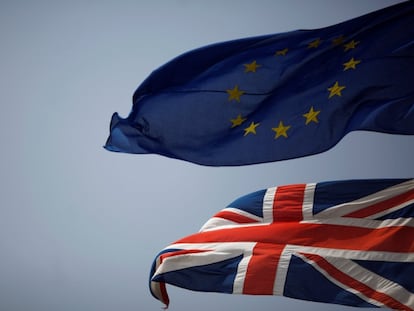Number of Spanish speakers tops 577 million
Data from the Cervantes Institute suggests that within the next 10 years more people will speak the language in the US than in Spain

In the late 1970s, a television program called 300 million, in reference to the number of Spanish speakers in the world, was broadcast in Spain, the Americas (including the US) and Equatorial Guinea. Today this program could be called 577 million, because that is how many people now speak the language, according to the Cervantes Institute, which has advanced some of the figures of its annual compilation The Spanish language in the world, due out in October.
480 million people are native Spanish speakers
There are now 577,256,327 Spanish speakers – five million more than the previous study, published in November 2017. This figure represents 7.6% of the global population. The United States, where President Donald Trump is openly suspicious of the Spanish language (criticizing Republican candidate Jeb Bush for using it), is in fact where “Don Quixote’s language is growing most vigorously, thanks mostly to demographics,” pointed out the academic director of the Cervantes, Richard Bueno Hudson, at the opening of a recent course called “Evolution of the Spanish language in the world.”
David Fernandez Vítores, a professor at University of Alcalá and a doctor of Spanish literature, underscored that if we were to walk across the US, we would find that 17.8% of the population is Hispanic, according to figures from 2016, and that “more than 70% of Latino families use this language at home, meaning that new generations are not losing the language of their grandparents.”
Fernández added that “although today there are 40 million Spanish speakers in the US, they will overtake the native Spanish community in a decade.” Hispanic Americans are concentrated in the southwest: Arizona, Texas, Florida, California and New Mexico.
Fernández tasked himself with breaking down the main figures in an effort to categorize who speaks Spanish. Spanish is the official language in 21 countries. Native speakers make up 480 million (there were 477 million at the previous count) – 434,875,921 who live in the Hispanic world, far exceeding those who live outside of it, 45,353,721.
Concerns
Professor Bueno noted the concern of English-speaking authorities because the numbers of those who speak English as their mother tongue are not rising, the opposite of what is happening with Spanish. Fernández stated that the number of Spanish native speakers is just behind that of Chinese, which in 2017 amounted to 960 million. “However, the international projection of this language is not as big.” Spanish also surpasses English, which has 399 million native speakers, according to figures from 2018. Further behind this is French, with 78 million.
More than 70% of Latino families speak Spanish at home Professor David Fernandez Vítores
The second group of speakers includes those with “limited competence” who manage to speak the language although with some difficulty: they make up 75 million, consisting of 24,747,993 in the Hispanic world and a further 24,747,993 outside of it. Here Shakespeare’s language takes gold for being the “lingua franca” of the world: over one billion. The final group of Hispanic speakers are the students learning the language, which includes 21 million speakers around the world. Among these, Fernández points out, two thirds are located in America and Brazil.
The keys of Spanish expansion, according to Bueno, are “its homogeneousness and the fact that it is internationally and geographically compact.” Someone living in Chihuahua, Mexico can understand a native of Zamora, Spain and very little of the language is lost because a lot of countries that use it share borders with each other. Fernandez Vítores, on the other hand, attributes it to other factors: Spanish has managed globalization due to the transnational communication networks and the elaboration of dictionaries and grammar books.
However, experts have noted the various hurdles faced by Spanish: the drive by French President Emmanuel Macron to promote French, and the poor presence of Spanish words in scientific journals. Fernández displayed in a graph Spanish's lack of impact in the 100 most-cited academic papers. While English claims first place, Spanish takes sixth, falling behind Chinese, Portuguese, Russian and German.
The economic presence of the languages was also noted, linking each language with GDP: countries that speak Spanish only represent 6.9% of the gross economic product of the planet, miles behind China which accounts for 18.2%, and light years away from English at 55%.
English version by John Clarke.
Tu suscripción se está usando en otro dispositivo
¿Quieres añadir otro usuario a tu suscripción?
Si continúas leyendo en este dispositivo, no se podrá leer en el otro.
FlechaTu suscripción se está usando en otro dispositivo y solo puedes acceder a EL PAÍS desde un dispositivo a la vez.
Si quieres compartir tu cuenta, cambia tu suscripción a la modalidad Premium, así podrás añadir otro usuario. Cada uno accederá con su propia cuenta de email, lo que os permitirá personalizar vuestra experiencia en EL PAÍS.
¿Tienes una suscripción de empresa? Accede aquí para contratar más cuentas.
En el caso de no saber quién está usando tu cuenta, te recomendamos cambiar tu contraseña aquí.
Si decides continuar compartiendo tu cuenta, este mensaje se mostrará en tu dispositivo y en el de la otra persona que está usando tu cuenta de forma indefinida, afectando a tu experiencia de lectura. Puedes consultar aquí los términos y condiciones de la suscripción digital.
More information
Archived In
Últimas noticias
Alain Aspect, Nobel laureate in physics: ‘Einstein was so smart that he would have had to recognize quantum entanglement’
Imelda Castro, the woman who wants to rule the cartel battleground of Sinaloa
The new victims of the Republican war on Obamacare: Millions hit by soaring health insurance premiums
A country divided on migrant rights: Some US states expand protections while others restrict them
Most viewed
- David King, chemist: ‘There are scientists studying how to cool the planet; nobody should stop these experiments from happening’
- Reinhard Genzel, Nobel laureate in physics: ‘One-minute videos will never give you the truth’
- Oona Chaplin: ‘I told James Cameron that I was living in a treehouse and starting a permaculture project with a friend’
- Sinaloa Cartel war is taking its toll on Los Chapitos
- Mexico completes its trade shift with the entry into force of tariffs on China and countries without trade agreements











































